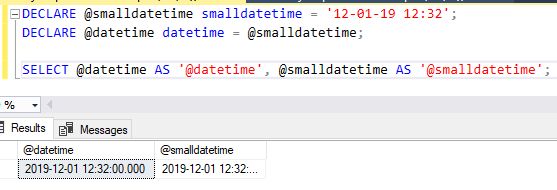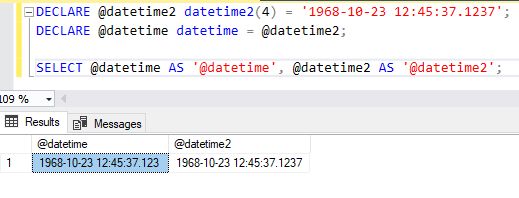SQL DATE TIME Statement
Introduction
In this chapter, we will learn how to use SQL Date and Time Data with various options.
SQL DATE statement
When working with SQL Date the most difficult part is to be sure that the format of the date you are trying to insert, matches the format of the date column in the database in SQL Server
As long as your data contains only the date portion, your queries will work as expected. However, if a time portion is involved, it gets more complicated in SQL.
The SQL Date defines a date that is combined with a time of day with fractional seconds that is based on a 24-hour clock
Note
Use the time date datetime2 and datetimeoffset data types for new work. These types align with the SQL standard
They are more portable times; datetime2 and datetimeoffset provide more seconds; precisiondatetimeoffset provides time zone support for globally deployed applications
SQL Date data types
SQL Server - SQL Server comes with the following data types for storing a date or a date/time value in the database
- DATE - format YYYY-MM-DD
- DATETIME - format: YYYY-MM-DD HH:MI: SS
- SMALLDATETIME - format: YYYY-MM-DD HH:MI:SS
- TIMESTAMP - format: a unique number
The date types are chosen for a column when you create a new table in your database
Working with Dates in SQL
You can compare two dates easily if there is no time component involved
We have the following OrderDetails table
Syntax
- Select * from OrderDetails
Example

Now we want to select the records with an OrderDate of 2019-04-11 from the table above
We use the following Select statement
Syntax
- SELECT FROM OrderDetails WHERE OrderDate='2019-04-11'
Example

Converting date and time data in SQL
Converting date and time data is when you convert to date and time data types, SQL Server rejects all values.
It doesn't recognize as dates or times for information about using the cast and convert functions with date and time data, see the cast and convert in SQL.
Converting date to other date and time types
Syntax
- DECLARE @date date = '12-21-16';
- DECLARE @datetime datetime = @date;
- SELECT @datetime AS '@datetime', @date AS '@date';
Example

The datetime is defined when the conversion is from time(n), the time component is copied, and the date component is set to '1900-01-01'.
When the fractional precision of the time(n) value is greater than three digits, the value will be truncated to fit.
The following example shows the results of converting a time(4)value to a datetime value.
Syntax
- DECLARE @time time(4) = '12:10:05.1237';
- DECLARE @datetime datetime = @time;
- SELECT @datetime AS '@datetime', @time AS '@time';
Example

The SQL date time conversion is from smalldatetime the hours and minutes are copied. The seconds and fractional seconds are set to 0.
The following code shows the results of converting a smalldatetime value.
Syntax
- DECLARE @smalldatetime smalldatetime = '12-01-19 12:32';
- DECLARE @datetime datetime = @smalldatetime;
- SELECT @datetime AS '@datetime', @smalldatetime AS '@smalldatetime';
Example

The time zone is truncated. When the fractional precision of the datetimeoffset(n)value is greater than three digits, the value will be truncated.
The following example shows the results of converting a datetimeoffset(4) value to a datetime value.
Syntax
- DECLARE @datetimeoffset datetimeoffset(4) = '1968-10-23 12:45:37.1234 +10:0';
- DECLARE @datetime datetime = @datetimeoffset;
- SELECT @datetime AS '@datetime', @datetimeoffset AS '@datetimeoffset';
Example

The Datetime is defined as when the conversion is from datetime2(n), the date and time are copied. when the fractional precision of the datetime2(n) value is greater than three digits, the value will be truncated.
The Datetime is defined as when the conversion is from datetime2(n), the date and time are copied.
When the fractional precision of the datetime2(n) value is greater than three digits, the value will be truncated.
The following example shows the results of converting a datetime2(4)value to a datetimevalue.
The following example shows datetime and datetime2 in SQL server
Syntax
- DECLARE @datetime2 datetime2(4) = '1968-10-23 12:45:37.1237';
- DECLARE @datetime datetime = @datetime2;
- SELECT @datetime AS '@datetime', @datetime2 AS '@datetime2';
Example

Syntax
- SELECT
- CAST'2019-05-18 12:35:29. 1234567 +12:15' AS "keyword">time(7)) AS 'time'
- ,CAST'2019-05-18 12:35:29. 1234567 +12:15' AS date AS 'date'
- ,CAST('2019-05-18 12:35:29.123' >AS smalldatetime) AS
- 'smalldatetime'
- ,CAST'2019-05-18 12:35:29.123' AS datetime) >AS 'datetime'
- ,CAST('2019-05-18 12:35:29. 1234567 +12:15' >AS datetime2(7)) AS
- 'datetime2'
- ,CAST'2019-05-18 12:35:29.1234567 +12:15' AS datetimeoffset(7)) AS
- 'datetimeoffset';
Example

Summary
In this chapter, we learned how to use SQL Aggregate statements with various options.
Author
Naresh Beniwal
Tech Writter
7.1k
1.8m
